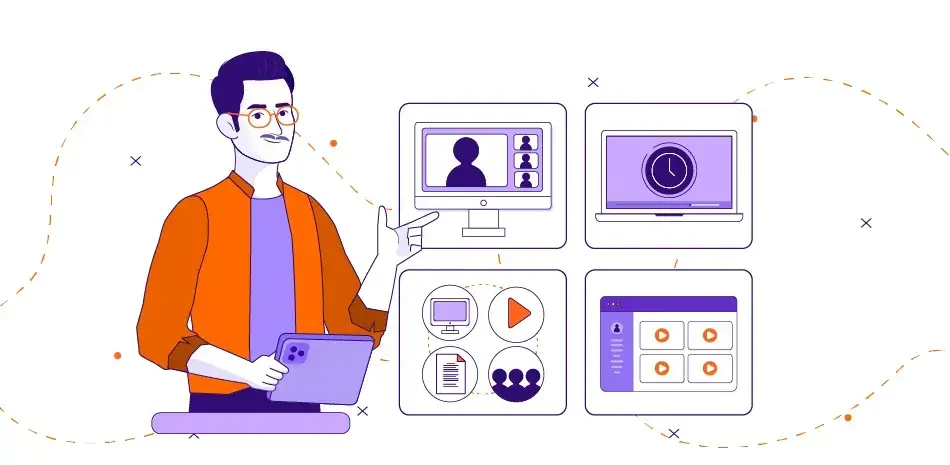
10 Types of Corporate Training Programs (and Uses in the Workplace)
It’s not a cliché to say that today’s workplace is fast-paced and constantly evolving. Between one day and the next, new technologies are developed, trends shift, and customer expectations change. With that, organizations are forced to be more agile and adaptable than ever before.
As a result, companies of all sizes are investing in training programs to keep their employees’ skills up-to-date and relevant. But not all corporate training is created equal; there are different types that serve different purposes.
In this guide, let’s explore the ten most common types of corporate training programs and how you can start implementing them in your organization.
What Is Corporate Training?
Corporate training, also known as workplace learning, consists of any organized activities designed to educate an organization’s personnel. Its purpose is to help employees acquire and refine skills and knowledge that will improve their performance in the workplace, both personally and professionally.
The responsibility of developing corporate training initiatives falls on the organization or employer (typically the human resources department), who must identify their employees’ needs and provide them with relevant learning opportunities. These programs must be easily accessible and offer a combination of theoretical and practical learning methods to ensure the best results.
Reasons Why Corporate Training Can Lead to Failure
Not all corporate training programs are successful; in fact, many fail to achieve their intended goals. Here are some reasons why:
- Lack of alignment with employee needs: If the training program isn’t tailored to address specific employee needs, it’ll fail to capture their attention and interest.
- Poorly designed content: The quality of the training material greatly impacts its effectiveness. If the content is outdated, irrelevant, or unengaging, employees are unlikely to retain what they have learned.
- Information overload: Trying to cram too much information into one training session can overwhelm employees and hinder their ability to absorb and apply what they have learned.
- Inadequate delivery methods: Different people learn in different ways, and if the training program only caters to one type of learner, it may not be effective for everyone.
- Lack of follow-up: Many organizations fail to follow up on the progress made by employees after completing a training program, resulting in low retention rates and minimal application of new skills.
Reasons Why Corporate Training Can Lead to Failure
Corporate employee training programs bring a host of benefits to both employees and employers. Here are the key advantages:
Cost Efficient
One of the primary advantages of corporate training programs is that they’re cost-efficient. By investing in employee development, companies can avoid high turnover rates and costly hiring processes. In most cases, the cost of training is significantly lower than the cost of recruiting and onboarding new employees.
Improved Employee Motivation
Did you know that 76% of millennials consider professional development opportunities as essential for a strong company culture and that 59% of employees believe that more training improves their performance? That goes to show that when employees feel like their employer is invested in their growth and development, they tend to be more engaged and motivated at work.
Building a Unified Company Culture
When employees go through the same training programs, it helps build a unified company culture since it ensures that everyone is on the same page when it comes to corporate values and goals. That’s in addition to helping create a shared understanding of company processes and procedures.
Reduced Turnover and Higher Retention Rates
A LinkedIn Learning survey found that 94% of employees would consider staying longer at their organizations if their company invested in their professional development. Simultaneously, research revealed that companies that provide comprehensive training programs have a 53% lower attrition rate compared to companies with minimal or no training programs.
It’s clear: the more a company invests in its employees’ development, the higher their retention rates.

Types of Corporate Training Programs
Corporate employee training programs bring a host of benefits to both employees and employers. Here are the key advantages:
1. Onboarding Training & Orientation
Onboarding training & orientation is the most common type of training. It’s held for all new hires and usually lasts from a few days to a couple of weeks right after an employee starts their job. The primary goal here is to help new employees quickly adapt to their new roles and become productive team members. Onboarding programs are typically broken down into two types:
- General Training: This type of training covers general information about the company, its history, mission, vision, and values. It also introduces new hires to corporate policies and regulations.
- Job-Specific Training: Job-specific training is focused on developing basic knowledge and skills necessary for a new hire to acquire a specific position. This type of training usually includes hands-on activities, job shadowing, and possibly mentorship programs.
Here’s a video example:
2. Leadership Training
Leadership training is designed for employees who show potential or have been newly promoted to a managerial or leadership position. It focuses on developing leadership skills, such as effective communication, decision-making, team management, strategic thinking, emotional intelligence, and conflict resolution. The goal of leadership training programs is to prepare executives for the challenges and responsibilities that come with their new role.
Here’s an example:
3. Soft Skills Training
Many employees have technical knowledge but lack crucial soft skills that are essential for their job performance. Soft skills programs focus on developing interpersonal and communication skills, time management, problem-solving, critical thinking, adaptability, and other personal attributes. This type of training can benefit employees at any level within an organization and can significantly impact the company’s ROI.
Here’s an example:
4. Diversity, Equity, and Inclusion (DEI) Training
Diversity, equity, and inclusion (DEI) training is crucial for creating a welcoming and inclusive workplace culture that doesn’t tolerate any form of discrimination or bias. These development programs aim to increase employee awareness and understanding of diversity, promote inclusion, and address issues related to systemic barriers and inequalities.
DEI training covers topics such as cultural sensitivity, unconscious bias, promoting gender equality, accessible environments, and more. Simply, it empowers employees to embrace differences, contribute to an environment of respect and belonging, and drive positive organizational change in alignment with ethical and social responsibilities.
Here’s an example:
5. Compliance Training
As mentioned earlier, compliance training is a crucial part of onboarding new employees and an ongoing effort to keep the workforce up-to-date with applicable laws and regulations. This type of training ensures that employees understand company policies and procedures, legal requirements, and ethical standards for conducting business.
Compliance training can vary based on job roles, locations, industry-specific regulations, and other factors. Some common types include anti-harassment and diversity training, business ethics, workplace safety, data protection and privacy training, and more.
Here’s an example:
6. Workplace Safety Training
In some industries, workplace safety training is mandatory for all employees to ensure their physical well-being and protect the company from potential lawsuits. Workplace safety training aims to educate employees on how to identify and mitigate hazards in the workplace, use equipment safely, prevent injuries and accidents, and respond appropriately in emergency situations. It can also cover topics such as ergonomics, fire safety, first aid, and more.
Here’s an example:
7. Sales Enablement Training
The sales department is usually the revenue-generating engine of a company, and its effectiveness can greatly impact the success of the organization. Sales enablement training equips sales teams with the knowledge, skills, and tools they need to effectively sell products or services. It covers areas such as product knowledge, objection handling, effective communication techniques, negotiation skills, customer relationship management, and more.
This type of training can also help sales teams stay updated on market trends, competitor analysis, and industry updates.
Here’s an example:
8. Technical Skills Training
In today’s fast-paced and technology-driven world, employees need to continually update their technical skills to stay relevant in their roles. This type of business skills training covers a wide range of topics, from basic computer skills to advanced software or programming languages.
This type of training is especially important for IT professionals who need to keep up with ever-evolving technologies. It can also be beneficial for employees in other roles, as it can improve overall efficiency and productivity in the workplace.
Here’s an example:
9. Cybersecurity Training
Cybersecurity training is especially relevant in today’s digital age, where cyber threats are constantly evolving and becoming more sophisticated. This type of training aims to educate employees on how to identify and prevent cyber attacks, protect sensitive data, and respond appropriately in the event of a security breach. It can cover areas such as password management, email security, social engineering, data encryption, and more.
Cybersecurity training is essential for all employees, as everyone plays a role in keeping the organization’s data and systems safe.
Here’s an example:
10. Product Knowledge Training
Finally, product knowledge training is essential for employees who need to have a thorough understanding of the company’s products or services.
This type of training helps team members confidently speak with customers about what the organization offers, including its features, benefits, uses, and costs. It’s often included in the onboarding program for new hires and can also be useful for existing employees who need to refresh their knowledge.
Product knowledge training is also especially important when a new feature or product is introduced, ensuring that all staff members are up to date and can effectively communicate with customers.
Here’s an example:
How to Organize Your Corporate Training
Now that you have a better understanding of the different types of corporate learning and training available, it’s time to think about how you’ll deliver these programs to your employees. Here are the three main types of training methods or delivery formats:
1. Online Learning (eLearning)
Online learning, also known as eLearning, is the most popular training delivery method for corporate learning and development. The industry has been witnessing significant growth ever since 2002, and today, more than 41.7% of Fortune 500 companies rely on online learning for their training needs.
Online training involves using digital platforms like learning management systems (LMS), virtual classrooms, and other web-based tools to deliver the content. Employees can access these programs at any time, from anywhere, making it a convenient, cost-effective, and flexible option.
2. Instructor-Led Training (ILT)
Instructor-led training (ILT) is what most employees associate with traditional classroom training. This method is often used for technical, compliance, and skills-based training, and it could take two forms:
- Classroom-Based Training: When employees physically attend a training session in a designated location, where an instructor delivers the content.
- Virtual or Online Classroom Training: This one involves delivering the content through live webinars, video conferencing, or other digital tools to participants located in different locations.
3. Blended Learning
As its name suggests, blended learning is a combination of online and instructor-led training. This method allows organizations to take advantage of the benefits of both formats and deliver more comprehensive and engaging training programs. Employees can complete some components of the course online, at their own pace, while attending a few in-person sessions for hands-on practice or group discussions.
Blended learning is gaining popularity for its ability to accommodate different learning styles and preferences. With this approach, employees can engage with the content in multiple ways, increasing knowledge retention and the overall effectiveness of the training.

How to Get Started With Ninja Tropic
Out of all of this, the key takeaway is clear: corporate training programs aren’t a one-size-fits-all solution. Every organization has unique content objectives and training needs, and it’s essential to have a tailored approach to be able to witness the powerful results that corporate training can bring.
At Ninja Tropic, that’s specifically what we specialize in: making every corporate training program a perfect fit for each organization’s specific needs. Our team of eLearning experts is here to help you analyze your content objectives and map out the interactive blueprint to achieve them. And the best part? It starts with a simple, free 30-minute consultation – obligation-free. Schedule yours today!
DOWNLOAD YOUR KEY TO KNOWLEDGE
Access Valuable Resources to Fuel Your Learning Journey


